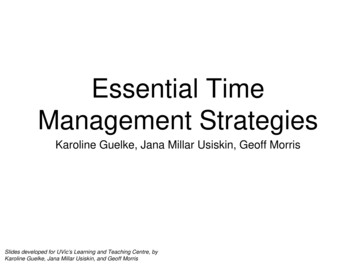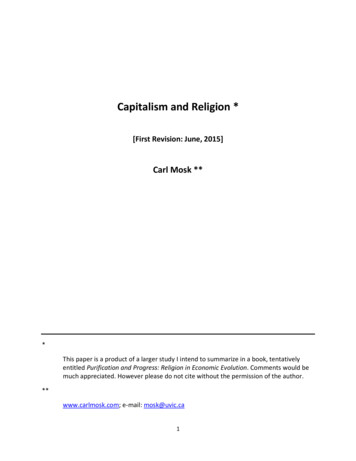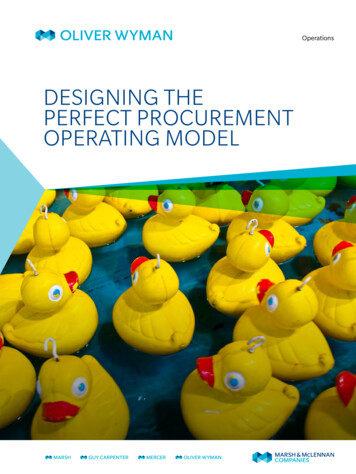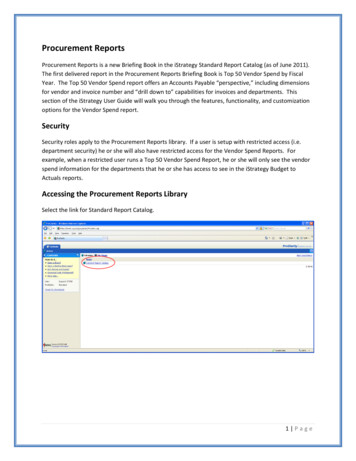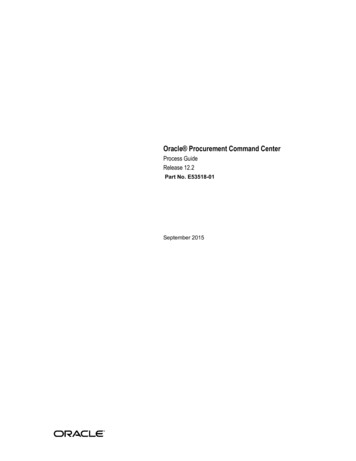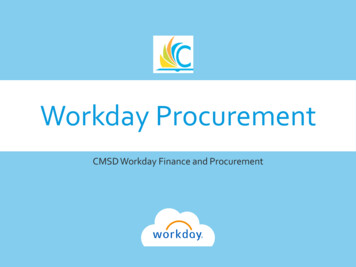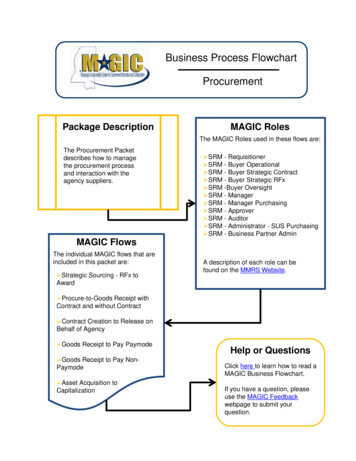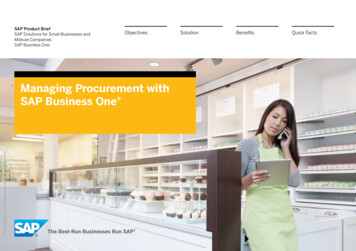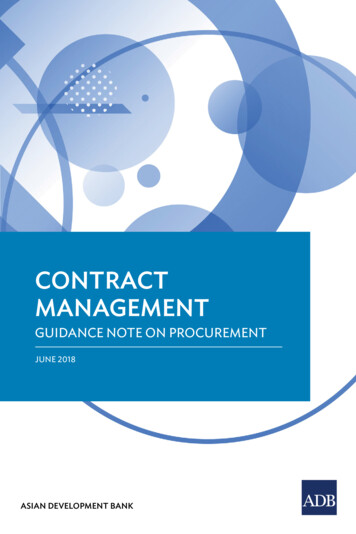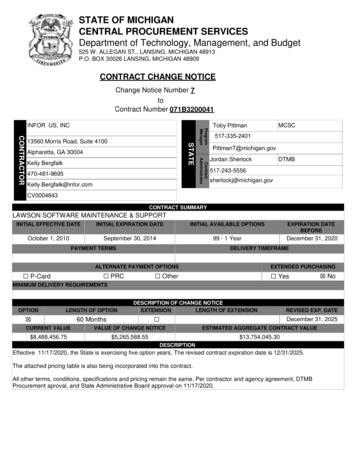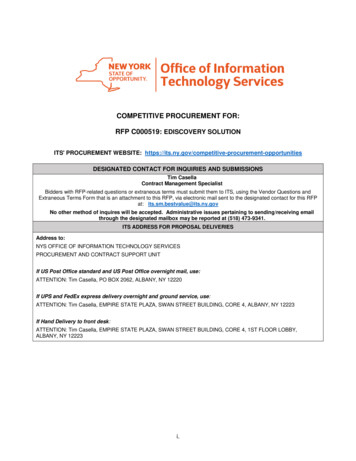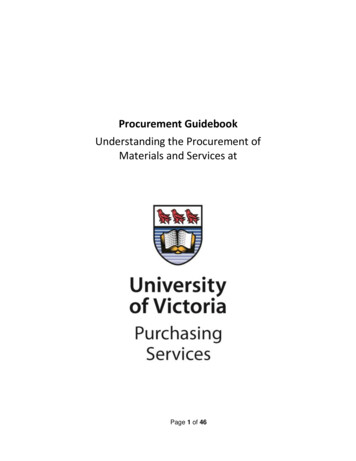
Transcription
Procurement GuidebookUnderstanding the Procurement ofMaterials and Services atPage 1 of 46
1Procurement Guidebook2Understanding the Procurement of Materials and Services at UVic34Table of Contents561Procurement at UVic .41.17Regulatory Requirements . 581.1.1Canadian Common Law/ Contract Requirements . 591.1.2New West Partnership Trade Agreement . 6101.1.3Agreement on Internal Trade (AIT) . 6111.1.4Trade, Investment and Labour Mobility Agreement (TILMA) . 7121.1.5Freedom of Information and Protection of Privacy Act (FOIPPA) . 7131.2Fairness and Transparency . 8141.3Purchasing Services . 8151.3.1Departments. 9161.3.2Procurement Roles . 917182Sourcing . 102.1Preparation and Procurement Strategy . 11192.1.1Receiving a New Sourcing Request . 12202.1.2Use of Formal Information-gathering mechanisms . 14212.1.3Selecting a Competition Level . 16222.1.4Selecting the Sourcing Mechanism . 19232.1.5Engaging the Competition Teams . 20242.2Competitive Sourcing Documents and Contracts . 22252.2.1Procurement Risk . 23262.2.2RFQ, RFT or RFP? . 24272.2.3Drafting the Competitive Procurement Documents . 25282.2.4Providing additional information in the form of Reference Information . 26292.2.5Conducting the review phase . 27302.3Advertising and Communication with the Market . 27312.3.1BC Bid & Merx . 27322.3.2Submission Response Time . 282
2.3.31Communication with Respondents during Competition. 2822.4Receipt of Responses. 3032.5Evaluation of Responses . 3142.5.1Evaluation Protocol . 3152.5.2Evaluation . 312.66Negotiation and Award . 3372.6.1Recommendation Memo . 3382.6.2Tender Award . 3392.6.3RFP Negotiation and Award . 33102.6.4Webreq and Subsequent PO following FAST Approval Checklist. 34112.6.5Debriefing . 35122.6.6Cancellation . 35133Contract Administration . 363.114Contract Renewals and Changes . 36153.1.1Renewal of AGR . 36163.1.2Change Orders . 36173.2Commercial Documentation . 36183.3Closing of Orders . 37193.4Payments . 37204Reports. 37215Document Handling . 37226Conclusion . 38237Glossary of Terms . 3824Appendix A – RFP Checklist .125Appendix B - Standard Award Letter .Error! Bookmark not defined.26Appendix C - Standard Letter to Lead Proponent.Error! Bookmark not defined.27Appendix E - Procurement File Checklist .6283
1Introduction234The main purposes of this procurement guidebook are to help interpret UVicprocurement policies and procedures and to give guidance on procurement decisionmaking.5The procurement guidebook’s primary focus is on sourcing related decision-makingsince this has the broadest applicability across UVic and the complexity of sourcingrelated decisions is highest. Thus, the procurement guidebook does not provide detailedguidance on all aspects of the procurement process. Please note the following, inparticular:678910111213 The procurement guidebook is not a step-by-step procedure orinstructions document. For detailed instruction, please see the SOP ordocumentation related to the Procurement Procedures required.1415 Specific positions where responsibilities fall have not been identified sincejob titles and responsibilities vary across departments.1617 The intent of the procurement guidebook is to be aligned with UVic’spolicies and procedures.1819202122231Procurement at UVicThe application of the Purchasing Services Policy FM5105 and Processes within UVic hasthe following core goals:1. the use of sound procurement practices in order to support UVic’sobjective of procuring materials and services that represent the highestoverall value to the University;4
122. the fostering of a fair and competitive procurement environment in whichmaterials and services are procured on behalf of UVic; and343. compliance with applicable law, including regulatory requirements anddirectives.In order to reach these goals UVic has:56 developed and implemented Procurement Policy and Procedures78 assigned clear responsibility for achieving the University’s procurementpolicy objectives;910 defined accountability for setting procurement strategy and achievingprocurement results;1112 implemented procedures in support of the application of consistent andprofessional standards in the procurement of materials and services; and131415 committed to utilize procurement practices and processes that aretransparent and open, and that are designed to ensure suppliers aretreated with courtesy, fairness, respect, honesty and professionalism.1617181.1Regulatory RequirementsUVic’s procurement activities are governed by legislation and trade agreementsincluding:19 Canadian common law20 New West Partnership Trade Agreement (NWPTA)21 Agreement on Internal Trade (AIT)22 Trade, Investment and Labour Mobility Agreement (TILMA)23 Freedom of Information and Protection of Privacy Act (FOIPPA)Further details on each of these can be found in the subsections below.24251.1.1Canadian Common Law/ Contract Requirements2627282930Under Canadian law, a contractual relationship will arise between an owner such asUVic and any respondent who submits a compliant bid in response to a Request forTenders (and, in some cases, in response to a Request for Proposals). This is known as“Contract A”, or the bid contract. “Contract B”, or the performance contract, ariseswhen the owner awards the tendered work to a compliant respondent.3132333435Although the law surrounding Contract A/Contract B is complex, Contract A basicallyrequires UVic to treat all respondents fairly and equally, and to conduct theprocurement in accordance with the terms and conditions of the procurementdocuments (including process requirements and stated evaluation criteria). Failure to doso may result in UVic being exposed to costly and time-consuming legal claims.5
11.1.2New West Partnership Trade Agreement234567891011121314The New West Partnership Trade Agreement (NWPTA) is an accord between theGovernments of British Columbia, Alberta and Saskatchewan that creates Canada'slargest, barrier-free, interprovincial market.151617The first Protocol of Amendment to the NWPTA was signed in January 2015. TheProtocol clarified language around labour mobility and dispute resolution provisions,and introduced a bid protest mechanism effective July 1, 2015.18British Columbia, Alberta and Saskatchewan have also committed to:Under the NWPTA, British Columbia, Alberta and Saskatchewan are the firstjurisdictions in Canada to commit to full mutual recognition or reconciliation of theirrules affecting trade, investment or labour mobility so as to remove barriers to the freemovement of goods, services, investment, and people within and between the threeprovinces. The NWPTA builds on the Trade, Investment and Labour MobilityAgreement (TILMA) between British Columbia and Alberta and has the claritySaskatchewan was seeking on public ownership of Crowns and the ability ofmunicipalities to support economic development. The NWPTA came into effect July 1,2010 and has been fully implemented since July 1, 2013.1920 Avoid measures that operate to restrict or impair trade between or throughtheir territories, or investment or labour mobility between them.2122 Treat businesses, investors and workers of the other two provinces at least asfavourably as they treat their own or those of another jurisdiction.2324 Mutually recognize or otherwise reconcile unnecessary differences in theirstandards and regulations.252627 Be fully transparent, and notify each other of any proposed measure that iscovered by the Agreement. The objective is to ensure that new measures donot create new impediments.282930 Having an enforceable dispute resolution mechanism that is accessible bygovernments, businesses, workers and investors in order to ensure that eachprovince lives up to its commitments.Persons engaged in procurement activities on behalf of UVic should be aware of thelegal implications of the processes being used, and the importance of conducting allprocurements in accordance with the processes and criteria set out in the relevantdocuments. The competitive process itself may result in the formation of Contract Acontractual obligations on UVic, regardless of whether any award of work is made.31323334353637381.1.3Agreement on Internal Trade (AIT)The Agreement on Internal Trade aims to reduce barriers to the movement of persons,materials, services and investments within Canada. Under its direction, UVic is obligated6
to follow certain procurement procedures to avoid creating barriers to free trade withinthe country (including provincial/local preference). In particular, under the terms of theAIT, all procurement opportunities meeting or exceeding established thresholds (i.e., 500,000 for materials and services; 5 million for construction) must be accessible toall Canadian suppliers through the use of electronic tendering systems or other meansthat satisfy the requirements of public advertisement (UVic will use BC Bid).12345671.1.4Trade, Investment and Labour Mobility Agreement (TILMA)8910111213The British Columbia – Alberta Trade, Investment and Labour Mobility Agreement isintended to remove barriers to trade and requires non-discrimination in the purchaseof: materials, services and construction from within the economic region (BC andAlberta). The concept of non-discrimination is equivalent to that covered by the AIT, butthe thresholds that apply are lower under the TILMA regulations ( 10,000 for materials; 75,000 for non-construction services; 100,000 for construction services).14Crown Corporations including UVic are subject to TILMA procurement requirements.151.1.5Freedom of Information and Protection of Privacy Act (FOIPPA)1617The purposes of FOIPPA (the ‘Act’) are to make public bodi
19 The application of the Purchasing Services Policy FM5105 and Processes within UVic has 20 the following core goals: 21 1. the use of sound procurement practices in order to support UVic [s 22 objective of procuring materials and services that represent the highest 23 overall value to the University; 5 1 2. the fostering of a fair and competitive procurement environment in which 2 materials .
